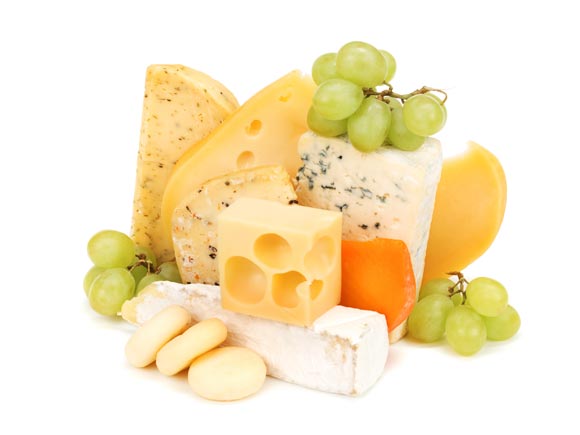 Forget Cheez Whiz. This is the Cheese Quiz. With so much focus placed on locally-produced wines in this issue (see our article on the Great River Wine Trail, p. 68), a primer on Wisconsin cheeses seems like a natural pairing. Test your cheese IQ. Answers are posted below the questions.
Forget Cheez Whiz. This is the Cheese Quiz. With so much focus placed on locally-produced wines in this issue (see our article on the Great River Wine Trail, p. 68), a primer on Wisconsin cheeses seems like a natural pairing. Test your cheese IQ. Answers are posted below the questions.
1. What’s the difference between Blue Cheese and Gorgonzola cheese?
2. Which of these is not a semi-soft cheese?
a. Fontina b. Romano c. Monterey Jack d. Havarti
3. What is “Cold Pack” and where does it come from?
4. How many varieties of cheese are produced in Wisconsin?
a. 100 b. 200 c. 400 d. 600
5. Which of the following are examples of Pasta Filata cheeses?
a. Mozzarella, Provolone and String
b. Feta, Marscapone and Ricotta
c. Brie and Camembert
6. What cheeses are known for their snowy white, edible rinds?
7. How old must a cheese get before it is called “aged”?
8. Can you name at least one Alpine-style cheese produced in Wisconsin?
9. What does the term “artisan cheese” mean?
10. Prior to 1850, most cheese produced in the United States was what kind?
a. Swiss
b. Cheddar
c. American processed cheese singles
d. Cottage
11. What is an “affineur”?
12. What cheese won the 2010 World Championship Cheese Title in Madison, Wis., this year?
Quiz Answers
1. Italian Gorgonzola is among trademarked varieties of blue cheeses, as are English Stilton and Roquefort. All are sharp, salty and intense, but Wisconsin Gorgonzola tends to be aged longer than some blue cheese (90 days is typical) and is therefore a bit subtler in flavor and creamier in texture. Gorgonzola is the Italian town where the cheese originated. And yes, a harmless form of mold causes the bluish veins in these cheeses.
2. b. Romano is a hard cheese. Semi-soft cheeses, like Wisconsin Monterey Jack, Brick, Muenster, Fontina and Havarti, are made with whole milk and melt when cooked. Hard cheeses are well-aged, easy to grate and mostly used in cooking.
3. “Cold Pack” is the invention of a Wisconsin tavern owner and refers to spreadable cheese for snacking. Taverns were called “clubs” and owners packed the cheese in crocks, so the cheese became known as Club or Crock Cheese, or Cold Pack. It is a natural, spreadable product blended without the aid of heat.
4. More than 600 varieties of cheese are produced in Wisconsin’s 140-plus cheese plants, adding up to about 2,500 million pounds each year.
5. a. Pasta Filata cheeses have curds that are heated and stretched or kneaded before being molded into shape, as with Mozzarella, Provolone and String.
6. Brie and Camembert cheeses, both made in Wisconsin in classic French styles, are soft and creamy with edible white rinds made from a harmless mold. The rinds taste very earthy and musty.
7. “Aged” generally refers to cheeses that have been cured, or ripened, for six months or longer. They tend to have a fuller, sharper flavor.
8. If you said Swiss, Gruyere, Gouda or Edam, you would be correct.
9. Artisan cheeses are generally made in small batches, sometimes with milk sourced from very specific farms. Like wine, their unique flavor profiles are related to their geography.
10. b. Cheddar. Wisconsin began making Cheddar in the mid-1800s and is the U.S. leader of Cheddar production today. Cheddar originated in the English village of Cheddar and remains the most popular cheese sold in the United Kingdom.
11. One who cures cheese. This comes from the French “affine,” meaning “to finish or refine.”
12. A Gruyere produced in La Brevine, Switzerland, took top honors out of 2,318 entries from 20 countries this year. The United States dominated the competition, earning gold medals in 51 of the total 79 cheese and butter categories judged. Canada and the Netherlands placed second and third. Among U.S. states, Wisconsin led with 21 gold medals, followed by New York (6), Idaho (5) and California (4).






















































